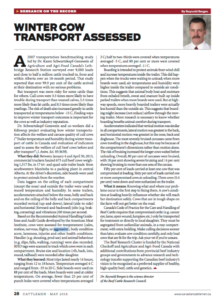Winter Cow Transport Assessed
This article written by Dr. Reynold Bergen, BCRC Science Director, originally appeared in the May 2016 issue of Canadian Cattlemen magazine and is reprinted on the BCRC Blog with permission of the publisher.
A 2007 transportation benchmarking study led by Dr. Karen Schwartzkopf-Genswein of Agriculture and Agri-Food Canada’s Lethbridge Research Station surveyed over 9,000 loads and close to half a million cattle trucked to, from and within Alberta over an 18 month period. That study reported that over 99.9% cattle arrived in their destination with no serious problems.
But transport was more risky for some cattle than for others. Cull cows were 3.5 times more likely to have trouble during transport than weaned calves, 5.5 times more likely than fat cattle, and 8.5 times more likely than yearlings. The risk of death also increased greatly in cattle transported at temperatures below -15oC. Finding ways to improve winter transport outcomes is important for the cows as well as industry reputation.
Dr. Schwartzkopf-Genswein and co-workers did a follow-up project evaluating how winter transportation affects the welfare and carcass quality of cull cows (“Trailer temperature and humidity during winter transport of cattle in Canada and evaluation of indicators used to assess the welfare of cull beef cows before and after transport”; J. Anim. Sci. 93:3639).
What they did
Between January 4 and April 30, 2013, commercial truckers hauled 673 cull beef cows weighing 1517lb in 17 tri- and quad-axle trailer loads from southwestern Manitoba to a packing plant in central Alberta. At the driver’s discretion, side boards were used to protect animals from the weather.
Data loggers on the ceiling of each compartment (except the nose) and outside the trailer were used to record temperature and humidity. In some trailers, accelerometers attached below the nose, belly and back and on the ceiling of the belly and back compartments recorded vertical (up-and-down), lateral (side-to-side) and horizontal (forward-and-backward) jolts (e.g. braking, cornering) and vibrations 200 times per second.
Based on the Recommended Animal Handling Guidelines and Audit Guide developed by the American Meat Institute, cows were assessed for temperament (calm, restless, nervous, flighty, or aggressive), body condition score, lameness, injuries and other health conditions. Handler (e.g. shouting, prod use) and animal behaviour (e.g. slips, falls, walking, running) were also recorded. RFID tags were scanned to track which cows were in each compartment. Bruise size and location (rib, back, loin, round, tailhead) were recorded after slaughter.
What they learned
Most trips lasted nearly 14 hours, ranging from 12 to 18 hours. Temperature averaged 4oC and ranged from -33 to 20oC. Side boards were used on 88% of the loads. More boards were used at colder temperatures. On average, fewer than 25% of punch holes were covered when temperatures averaged 2oC; half to two thirds were covered when temperatures averaged-5oC, and 80% or more were covered when temperatures averaged -11oC. Boarding is intended to protect animals from wind chill and increase temperatures inside the trailer. This did happen when the trucks were waiting to unload; when more boards were used, air temperatures and humidity were higher inside the trailer compared to outside air conditions. This suggests that animal body heat and moisture from exhaled breath, sweat and manure built up inside parked trailers when more boards were used. But at highway speeds, more heavily boarded trailers were actually less humid than the outside air. This suggests that boarding might increase (not reduce) airflow through the moving trailer. More research is necessary to know whether boarding benefits animal comfort during transport.
Accelerometers indicated that vertical motion was similar in all compartments, lateral motion was greatest in the back, and horizontal motion was greatest in the nose, back and doghouse. The most severely bruised carcasses came from cows traveling in the doghouse, but this may because of the compartment’s dimensions rather than motion alone. The risk of bruising increased the longer cows waited before unloading. Overall, 80% of carcasses were bruised, with 18% showing severe bruising and 14% showing bruising in more than one area of the carcass.
Fifty percent of loads carried at least one cow that was compromised at loading. Sixty percent of loads carried one or more compromised cows at unloading. Three cows (0.4%) went down and were euthanized on the trailer.
What it means
Knowing what and where our problems are is the first step to fixing them. A cow’s condition at loading heavily influences whether she will reach her destination safely. Cows that are in tough shape on the farm will not get better on the road. Canada’s Code of Practice for the Care and Handling of Beef Cattle requires that compromised cattle (e.g. cancer eye, lame, open wound, lumpjaw, etc.) only be transported for treatment or directly to local slaughter. They must be segregated from unfamiliar animals, in a rear compartment, with extra bedding. Make culling decisions sooner than later, evaluate cow condition carefully, and only load cows that are fit for the trip. Ask your vet if you’re unsure.
Click here to subscribe to the BCRC Blog and receive email notifications when new content is posted.
The sharing or reprinting of BCRC Blog articles is typically welcome and encouraged, however this article requires permission of the original publisher.
We welcome your questions, comments and suggestions. Contact us directly or generate public discussion by posting your thoughts below.
